Citizen Science and the Sustainable Development Goals: Building Social and Technical Capacity through Data Collection in the Upper Blue Nile Basin, Ethiopia
Abstract
:1. Introduction
2. Materials and Methods
2.1. Overview of Citizen Science Initiative Design
2.2. Citizen Science Initiative Process
2.2.1. Selection of Data Collection Sites and Citizen Scientists
2.2.2. Citizen Science Training
2.2.3. Data Collection
2.2.4. Developing a Soil Moisture Measuring Solution
2.2.5. Social Scientific Analysis and Interview Methods
2.2.6. Assessment of Outcomes
3. Results
3.1. Technical Results: Hydrological Datasets
3.1.1. Evaluation of the Novel Soil Moisture Sensors for Farm-Level Monitoring
3.1.2. Assessing Hydrological Characteristics
3.1.3. Application of CSI in Evaluating Physical Models
3.1.4. Comparing Citizen Science Data to the Seasonal Forecast
3.1.5. Knowledge and Science Contributions of the Data
3.1.6. Aligning the Technical Outcome to the SDGs
3.2. Social Scientific Analysis: Evaluating the Indiviual, Programmatic and Community-Level Outcomes towards the SDGs
3.2.1. The Social Network and the SDGs
- Target 4.7, ‘by 2030, ensure that all learners acquire the knowledge and skills needed to promote sustainable development, including, among others, through education for sustainable development and sustainable lifestyles, human rights, gender equality, promotion of a culture of peace and non-violence, global citizenship and appreciation of cultural diversity and of culture’s contribution to sustainable development’, by acquiring technical skills that aid in hydrologic data collection and environmental discussion, working with individuals from other cultures and learning about the formal research scientific process,
- Target 4.5, ‘by 2030, eliminate gender disparities in education and ensure equal access to all levels of education and vocational training for the vulnerable, including persons with disabilities, indigenous peoples and children in vulnerable situations’, for the women citizen scientists who engaged despite their reported difficulties,
- Target 4.4, ‘by 2030, substantially increase the number of youth and adults who have relevant skills, including technical and vocational skills, for employment, decent jobs and entrepreneurship’, by working in this multi-year CSI in a data-scarce region and demographic that is otherwise unseen and unheard, and,
- Target 1.5, ‘By 2030, build the resilience of the poor and those in vulnerable situations and reduce their exposure and vulnerability to climate-related extreme events and other economic, social and environmental shocks and disasters’, by increasing their social network of the high school students to their teachers, graduate students, higher education faculty, increasing self-efficacy and being included in knowledge sharing with their peers and field professionals.
3.2.2. Program Analysis and the SDGs
3.2.3. Individual Outcome and the SDGs
4. Study Challenges
5. Conclusions
Author Contributions
Funding
Institutional Review Board Statement
Informed Consent Statement
Data Availability Statement
Acknowledgments
Conflicts of Interest
Appendix A. Reference of SDG Targets from Analysis
| Sustainable Development Goal | Target |
| Goal 1. End poverty in all its forms everywhere | 1.5 By 2030, build the resilience of the poor and those in vulnerable situations and reduce their exposure and vulnerability to climate-related extreme events and other economic, social and environmental shocks and disasters |
| Goal 2. End hunger, achieve food security and improved nutrition and promote sustainable agriculture | 2.4 By 2030, ensure sustainable food production systems and implement resilient agricultural practices that increase productivity and production, that help maintain ecosystems, that strengthen capacity for adaptation to climate change, extreme weather, drought, flooding and other disasters and that progressively improve land and soil quality |
| 2.a Increase investment, including through enhanced international cooperation, in rural infrastructure, agricultural research and extension services, technology development and plant and livestock gene banks in order to enhance agricultural productive capacity in developing countries, in particular least developed countries | |
| Goal 4. Ensure inclusive and equitable quality education and promote lifelong learning opportunities for all | 4.4 By 2030, substantially increase the number of youth and adults who have relevant skills, including technical and vocational skills, for employment, decent jobs and entrepreneurship |
| 4.5 By 2030, eliminate gender disparities in education and ensure equal access to all levels of education and vocational training for the vulnerable, including persons with disabilities, indigenous peoples and children in vulnerable situations | |
| 4.7 By 2030, ensure that all learners acquire the knowledge and skills needed to promote sustainable development, including, among others, through education for sustainable development and sustainable lifestyles, human rights, gender equality, promotion of a culture of peace and non-violence, global citizenship and appreciation of cultural diversity and of culture’s contribution to sustainable development | |
| Goal 5. Achieve gender equality and empower all women and girls | 5.b Enhance the use of enabling technology, in particular information and communications technology, to promote the empowerment of women |
| Goal 6. Ensure availability and sustainable management of water and sanitation for all | 6.4 By 2030, substantially increase water-use efficiency across all sectors and ensure sustainable withdrawals and supply of freshwater to address water scarcity and substantially reduce the number of people suffering from water scarcity |
| 6.a By 2030, expand international cooperation and capacity-building support to developing countries in water- and sanitation-related activities and programmes, including water harvesting, desalination, water efficiency, wastewater treatment, recycling and reuse technologies | |
| 6.b Support and strengthen the participation of local communities in improving water and sanitation management | |
| Goal 9. Build resilient infrastructure, promote inclusive and sustainable industrialization and foster innovation | 9.5 Enhance scientific research, upgrade the technological capabilities of industrial sectors in all countries, in particular developing countries, including, by 2030, encouraging innovation and substantially increasing the number of research and development workers per 1 million people and development workers per 1 million people and public and private research and development spending |
| Goal 13. Take urgent action to combat climate change and its impacts | 13.3 Improve education, awareness-raising and human and institutional capacity on climate change mitigation, adaptation, impact reduction and early warning |
| 13.b Promote mechanisms for raising capacity for effective climate change-related planning and management in least developed countries and small island developing States, including focusing on women, youth and local and marginalized communities | |
| Goal 17. Strengthen the means of implementation and revitalize the global partnership for sustainable development | 17.18 By 2020, enhance capacity-building support to developing countries, including for least developed countries and small island developing States, to increase significantly the availability of high-quality, timely and reliable data disaggregated by income, gender, age, race, ethnicity, migratory status, disability, geographic location and other characteristics relevant in national contexts |
References
- SDG 6 Synthesis Report 2018 on Water and Sanitation; UN-WATER PUBLICATIONS: New York, NY, USA, 2018; Available online: https://sustainabledevelopment.un.org/content/documents/19901SDG6_SR2018_web_3.pdf (accessed on 13 October 2021).
- Hanjra, M.A.; Ferede, T.; Gutta, D.G. Reducing Poverty in Sub-Saharan Africa through Investments in Water and Other Priorities. Agric. Water Manag. 2009, 96, 1062–1070. [Google Scholar] [CrossRef]
- Namara, R.E.; Hanjra, M.A.; Castillo, G.E.; Ravnborg, H.M.; Smith, L.; van Koppen, B. Agricultural Water Management and Poverty Linkages. Agric. Water Manag. 2010, 97, 520–527. [Google Scholar] [CrossRef]
- Hagos, F.; Jayasinghe, G.; Awulachew, S.B.; Loulseged, M.; Yilma, A.D. Agricultural Water Management and Poverty in Ethiopia. Agric. Econ. 2012, 43, 99–111. [Google Scholar] [CrossRef] [Green Version]
- Forouzani, M.; Karami, E. Agricultural Water Poverty Index and Sustainability. Agron. Sustain. Dev. 2010, 31, 415–431. [Google Scholar] [CrossRef] [Green Version]
- Young, M.D.; Esau, C. Investing in Water for a Green Economy: Services, Infrastructure, Policies and Management. In Investing in Water for a Green Economy: Services, Infrastructure, Policies and Management, 1st ed.; Routledge: London, UK, 2013; pp. 1–272. [Google Scholar] [CrossRef]
- Transforming Our World: The 2030 Agenda for Sustainable Development (A/RES/70/1); United Nations General Assembly: New York, NY, USA, 2015; Available online: https://sustainabledevelopment.un.org/post2015/transformingourworld/publication (accessed on 12 December 2021).
- Leal Filho, W.; Tripathi, S.K.; Andrade Guerra, J.B.S.O.D.; Giné-Garriga, R.; Orlovic Lovren, V.; Willats, J. Using the Sustainable Development Goals towards a Better Understanding of Sustainability Challenges. Int. J. Sustain. Dev. World Ecol. 2019, 26, 179–190. [Google Scholar] [CrossRef]
- IAEG Revised List of Global Sustainable Development Goal Indicators. In Report of the Inter-Agency and Expert Group on Sustainable Development Goal Indicators (E/CN.3/2017/2)—Annex III; United Nations Economic and Social Council, Statistical Commission: New York, NY, USA, 2017; pp. 1–26.
- Ajates, R.; Hager, G.; Georgiadis, P.; Coulson, S.; Woods, M.; Hemment, D. Local Action with Global Impact: The Case of the Grow Observatory and the Sustainable Development Goals. Sustainability 2020, 12, 518. [Google Scholar] [CrossRef]
- Espey, J.; Swanson, E.; Badiee, S.; Christensen, Z.; Fischer, A.; Levy, M.; Yetman, G.; de Sherbinin, A.; Chen, R.; Yiu, Q.; et al. Data for Development: A Needs Assessment for SDG Monitoring and Statistical Capacity Development; Sustainable Development Solutions Network: New York, NY, USA, 2015. [Google Scholar]
- Fritz, S.; See, L.; Carlson, T.; Haklay, M.; Oliver, J.L.; Fraisl, D.; Mondardini, R.; Brocklehurst, M.; Shanley, L.A.; Schade, S.; et al. Citizen Science and the United Nations Sustainable Development Goals. Nat. Sustain. 2019, 2, 922–930. [Google Scholar] [CrossRef]
- Bonney, R.; Shirk, J.L.; Phillips, T.B.; Wiggins, A.; Ballard, H.L.; Miller-Rushing, A.J.; Parrish, J.K. Next Steps for Citizen Science. Science 2014, 343, 1436–1437. [Google Scholar] [CrossRef]
- Pocock, M.J.O.O.; Roy, H.E.; August, T.; Kuria, A.; Barasa, F.; Bett, J.; Githiru, M.; Kairo, J.; Kimani, J.; Kinuthia, W.; et al. Developing the Global Potential of Citizen Science: Assessing Opportunities That Benefit People, Society and the Environment in East Africa. J. Appl. Ecol. 2019, 56, 274–281. [Google Scholar] [CrossRef]
- Célleri, R.; Buytaert, W.; de Bièvre, B.; Tobón, C.; Crespo, P.; Molina, J.; Feyen, J.A.N. Understanding the Hydrology of Tropical Andean Ecosystems through an Andean Network of Basins. IAHS-AISH Publ. 2010, 336, 209–212. [Google Scholar] [CrossRef]
- Buytaert, W.; Zulkafli, Z.; Grainger, S.; Acosta, L.; Alemie, T.C.; Bastiaensen, J.; de Bièvre, B.; Bhusal, J.; Clark, J.; Dewulf, A.; et al. Citizen Science in Hydrology and Water Resources: Opportunities for Knowledge Generation, Ecosystem Service Management, and Sustainable Development. Front. Earth Sci. 2014, 2, 26. [Google Scholar] [CrossRef] [Green Version]
- Njue, N.; Stenfert Kroese, J.; Gräf, J.; Jacobs, S.R.; Weeser, B.; Breuer, L.; Rufino, M.C. Citizen Science in Hydrological Monitoring and Ecosystem Services Management: State of the Art and Future Prospects. Sci. Total Environ. 2019, 693, 133531. [Google Scholar] [CrossRef] [PubMed]
- Tripathi, A.; Mishra, A.K. Knowledge and Passive Adaptation to Climate Change: An Example from Indian Farmers. Clim. Risk Manag. 2017, 16, 195–207. [Google Scholar] [CrossRef]
- Conway, D.; Schipper, E.L.F. Adaptation to Climate Change in Africa: Challenges and Opportunities Identified from Ethiopia. Glob. Environ. Change 2011, 21, 227–237. [Google Scholar] [CrossRef]
- Kotir, J.H. Climate Change and Variability in Sub-Saharan Africa: A Review of Impacts on Agriculture and Food Security. Environ. Dev. Sustain. 2021, 23, 23–43. [Google Scholar] [CrossRef]
- Yeshanew, A.; Jury, M.R. Ethiopian Decadal Climate Variability. Theor. Appl. Climatol. 2010, 101, 29–40. [Google Scholar] [CrossRef]
- Gebrechorkos, S.H.; Hülsmann, S.; Bernhofer, C. Long-Term Trends in Rainfall and Temperature Using High-Resolution Climate Datasets in East Africa. Sci. Rep. 2019, 9, 11376. [Google Scholar] [CrossRef] [Green Version]
- Thornton, P.; Rosenstock, T.S. Future Climate Projections in Africa: Where Are We Headed? Clim.-Smart Agric. Pap. 2018, 4, 15–17. [Google Scholar] [CrossRef] [Green Version]
- Deressa, T.T.; Hassan, R.M. Economic Impact of Climate Change on Crop Production in Ethiopia: Evidence from Cross-Section Measures. J. Afr. Econ. 2009, 18, 529–554. [Google Scholar] [CrossRef]
- Moges, D.M.; Bhat, H.G. Climate Change and Its Implications for Rainfed Agriculture in Ethiopia. J. Water Clim. Change 2021, 12, 1229–1244. [Google Scholar] [CrossRef]
- Nigussie, L.; Haile, A.T.; Gowing, J.; Walker, D.; Parkin, G. Citizen Science in Community-Based Watershed Management: An Institutional Analysis in Ethiopia; International Water Management Institute (IWMI): Colombo, Sri Lanka, 2020; Volume 191. [Google Scholar] [CrossRef]
- Gebrehiwot, S.G.; Bewket, W.; Mengistu, T.; Nuredin, H.; Ferrari, C.A.; Bishop, K. Monitoring and Assessment of Environmental Resources in the Changing Landscape of Ethiopia: A Focus on Forests and Water. Environ. Monit. Assess. 2021, 193, 624. [Google Scholar] [CrossRef]
- van Loon, A.F. Hydrological Drought Explained. WIREs Water 2015, 2, 359–392. [Google Scholar] [CrossRef]
- Fraisl, D.; Campbell, J.; See, L.; Wehn, U.; Wardlaw, J.; Gold, M.; Moorthy, I.; Arias, R.; Piera, J.; Oliver, J.L.; et al. Mapping Citizen Science Contributions to the UN Sustainable Development Goals. Sustain. Sci. 2020, 15, 1735–1751. [Google Scholar] [CrossRef]
- Pateman, R.; Tuhkanen, H.; Cinderby, S. Citizen Science and the Sustainable Development Goals in Low and Middle Income Country Cities. Sustainability 2021, 13, 9534. [Google Scholar] [CrossRef]
- PIRE Home. Water and Food Security PIRE. Available online: https://pire.engr.uconn.edu/ (accessed on 22 August 2021).
- Dickinson, J.L.; Shirk, J.; Bonter, D.; Bonney, R.; Crain, R.L.; Martin, J.; Phillips, T.; Purcell, K. The Current State of Citizen Science as a Tool for Ecological Research and Public Engagement. Front. Ecol. Environ. 2012, 10, 291–297. [Google Scholar] [CrossRef] [Green Version]
- Cohn, J.P. Citizen Science: Can Volunteers Do Real Research? BioScience 2008, 58, 192–197. [Google Scholar] [CrossRef] [Green Version]
- Wiggins, A.; Newman, G.; Stevenson, R.D.; Crowston, K. IEEE Xplore Full-Text PDF. Mechanisms for Data Quality and Validation in Citizen Science. In Proceedings of the IEEE Seventh International Conference on e-Science Workshops, Stockholm, Sweden, 5–8 December 2011; pp. 14–19. [Google Scholar] [CrossRef]
- Danielsen, F.; Jensen, P.M.; Burgess, N.D.; Altamirano, R.; Alviola, P.A.; Andrianandrasana, H.; Brashares, J.S.; Burton, A.C.; Coronado, I.; Corpuz, N.; et al. A Multicountry Assessment of Tropical Resource Monitoring by Local Communities. BioScience 2014, 64, 236–251. [Google Scholar] [CrossRef] [Green Version]
- Evans, D.M. Citizen Science Comes of Age. Trends Ecol. Evol. 2013, 28, 451. [Google Scholar] [CrossRef]
- Jordan, R.C.; Ballard, H.L.; Phillips, T.B. Key Issues and New Approaches for Evaluating Citizen-Science Learning Outcomes. Front. Ecol. Environ. 2012, 10, 307–309. [Google Scholar] [CrossRef]
- Dile, Y.T.; Tekleab, S.; Kaba, E.A.; Gebrehiwot, S.G.; Worqlul, A.W.; Bayabil, H.K.; Yimam, Y.T.; Tilahun, S.A.; Daggupati, P.; Karlberg, L.; et al. Advances in Water Resources Research in the Upper Blue Nile Basin and the Way Forward: A Review. J. Hydrol. 2018, 560, 407–423. [Google Scholar] [CrossRef]
- Bo Tegnäs, S.D.; Johnson, E.P.; Yared Fekade Mandefro, S.J. Rural Households Socioeconomic Baseline Survey of 56 Woredas in the Amhara Region, Volume VII—Crop Production and Protection; Swedish International Development Cooperation Agency: Stockholm, Sweden; Bahir Dar, Ethiopia, 2009.
- Bewket, W. Rainfall Variability and Agricultural Vulnerability in the Amhara Region, Ethiopia. Ethiop. J. Dev. Res. 2008, 29, 823–836. [Google Scholar] [CrossRef]
- Awulachew, S.; Merrey, D.; Kamara, A.; van Koppen, B.; Penning de Vires, F.; Boelee, E.; Makombe, G. Experiences and Opportunities for Promoting Small-Scale/Micro Irrigation and Rainwater Harvesting for Food Security in Ethiopia; (Working paper 98); International Water Management Institute: Colombo, Sri Lanka, 2005; Volume 98, 86p. [Google Scholar]
- Awulachew, S.B.; Erkossa, T.; Namara, R. Irrigation Potential in Ethiopia: Constraints and Opportunities for Enhancing the System. Research Report, International Water Management Institute, Addis Ababa. Int. Water Manag. Inst. 2010, 3, 1–59. [Google Scholar] [CrossRef]
- Hailemichael, S.; Haug, R. The Use and Abuse of the ‘Model Farmer’ Approach in Agricultural Extension in Ethiopia. J. Agric. Educ. Ext. 2020, 26, 465–484. [Google Scholar] [CrossRef]
- Xu, Z.; Zhou, W.; Zhang, H.; Shen, M.; Liu, Y.; Cai, D.; Li, Y.; Lei, Y.; Wang, G.; Bagtzoglou, A.C.; et al. Flat Thin Mm-Sized Soil Moisture Sensor (MSMS) Fabricated by Gold Compact Discs Etching for Real-Time in Situ Profiling. Sens. Actuators B Chem. 2018, 255, 1166–1172. [Google Scholar] [CrossRef]
- Kieslinger, B.; Schäfer, T.; Heigl, F.; Dörler, D.; Richter, A.; Bonn, A. The Challenge of Evaluation: An Open Framework for Evaluating Citizen Science Activities. SocArXiv 2017, 1–31. [Google Scholar] [CrossRef] [Green Version]
- United Nations. Transforming Ethiopia Together: The United Nations in Ethipiopia; United Nations: New York, NY, USA, 2018. [Google Scholar]
- Sachs, J.D. From Millennium Development Goals to Sustainable Development Goals. Lancet 2012, 379, 2206–2211. [Google Scholar] [CrossRef]
- Khadim, F.K.; Dokou, Z.; Lazin, R.; Moges, S.; Bagtzoglou, A.C.; Anagnostou, E. Groundwater Modeling in Data Scarce Aquifers: The Case of Gilgel-Abay, Upper Blue Nile, Ethiopia. J. Hydrol. 2020, 590, 125214. [Google Scholar] [CrossRef]
- Karthikeyan, L.; Chawla, I.; Mishra, A.K. A Review of Remote Sensing Applications in Agriculture for Food Security: Crop Growth and Yield, Irrigation, and Crop Losses. J. Hydrol. 2020, 586, 124905. [Google Scholar] [CrossRef]
- Yang, D.; Yang, Y.; Xia, J. Hydrological Cycle and Water Resources in a Changing World: A Review. Geogr. Sustain. 2021, 2, 115–122. [Google Scholar] [CrossRef]
- Taing, L.; Dang, N.; Agarwal, M.; Glickman, T. Water-Related Sustainable Development Goal Accelerators: A Rapid Review. Water Secur. 2021, 14, 100100. [Google Scholar] [CrossRef]
- Assumpção, T.H.; Popescu, I.; Jonoski, A.; Solomatine, D.P. Citizen Observations Contributing to Flood Modelling: Opportunities and Challenges. Hydrol. Earth Syst. Sci. 2018, 22, 1473–1489. [Google Scholar] [CrossRef] [Green Version]
- Moczek, N.; Voigt-Heucke, S.L.; Mortega, K.G.; Fabó Cartas, C.; Knobloch, J. A Self-Assessment of European Citizen Science Projects on Their Contribution to the UN Sustainable Development Goals (SDGs). Sustainability 2021, 13, 1774. [Google Scholar] [CrossRef]
- le Coz, J.; Patalano, A.; Collins, D.; Guillén, N.F.; García, C.M.; Smart, G.M.; Bind, J.; Chiaverini, A.; le Boursicaud, R.; Dramais, G.; et al. Crowdsourced Data for Flood Hydrology: Feedback from Recent Citizen Science Projects in Argentina, France and New Zealand. J. Hydrol. 2016, 541, 766–777. [Google Scholar] [CrossRef] [Green Version]
- Fehri, R.; Khlifi, S.; Vanclooster, M. Testing a Citizen Science Water Monitoring Approach in Tunisia. Environ. Sci. Policy 2020, 104, 67–72. [Google Scholar] [CrossRef]
- Duddigan, S.; Alexander, P.D.; Shaw, L.J.; Sandén, T.; Collins, C.D. The Tea Bag Index-UK: Using Citizen/Community Science to Investigate Organic Matter Decomposition Rates in Domestic Gardens. Sustainability 2020, 12, 6895. [Google Scholar] [CrossRef]
- Thapa, R.B.; Matin, M.A.; Bajracharya, B. Capacity Building Approach and Application: Utilization of Earth Observation Data and Geospatial Information Technology in the Hindu Kush Himalaya. Front. Environ. Sci. 2019, 7, 165. [Google Scholar] [CrossRef]
- Eitzel, M.V.; Cappadonna, J.L.; Santos-Lang, C.; Duerr, R.E.; Virapongse, A.; West, S.E.; Kyba, C.C.M.; Bowser, A.; Cooper, C.B.; Sforzi, A.; et al. Citizen Science Terminology Matters: Exploring Key Terms. Citiz. Sci. Theory Pract. 2017, 2, 1. [Google Scholar] [CrossRef] [Green Version]
- Conrad, C.C.; Hilchey, K.G. A Review of Citizen Science and Community-Based Environmental Monitoring: Issues and Opportunities. Environ. Monit. Assess. 2011, 176, 273–291. [Google Scholar] [CrossRef]
- Jones, M.G.; Childers, G.; Andre, T.; Corin, E.N.; Hite, R. Citizen Scientists and Non-Citizen Scientist Hobbyists: Motivation, Benefits, and Influences. Int. J. Sci. Educ. Part B Commun. Public Engagem. 2018, 8, 287–306. [Google Scholar] [CrossRef]
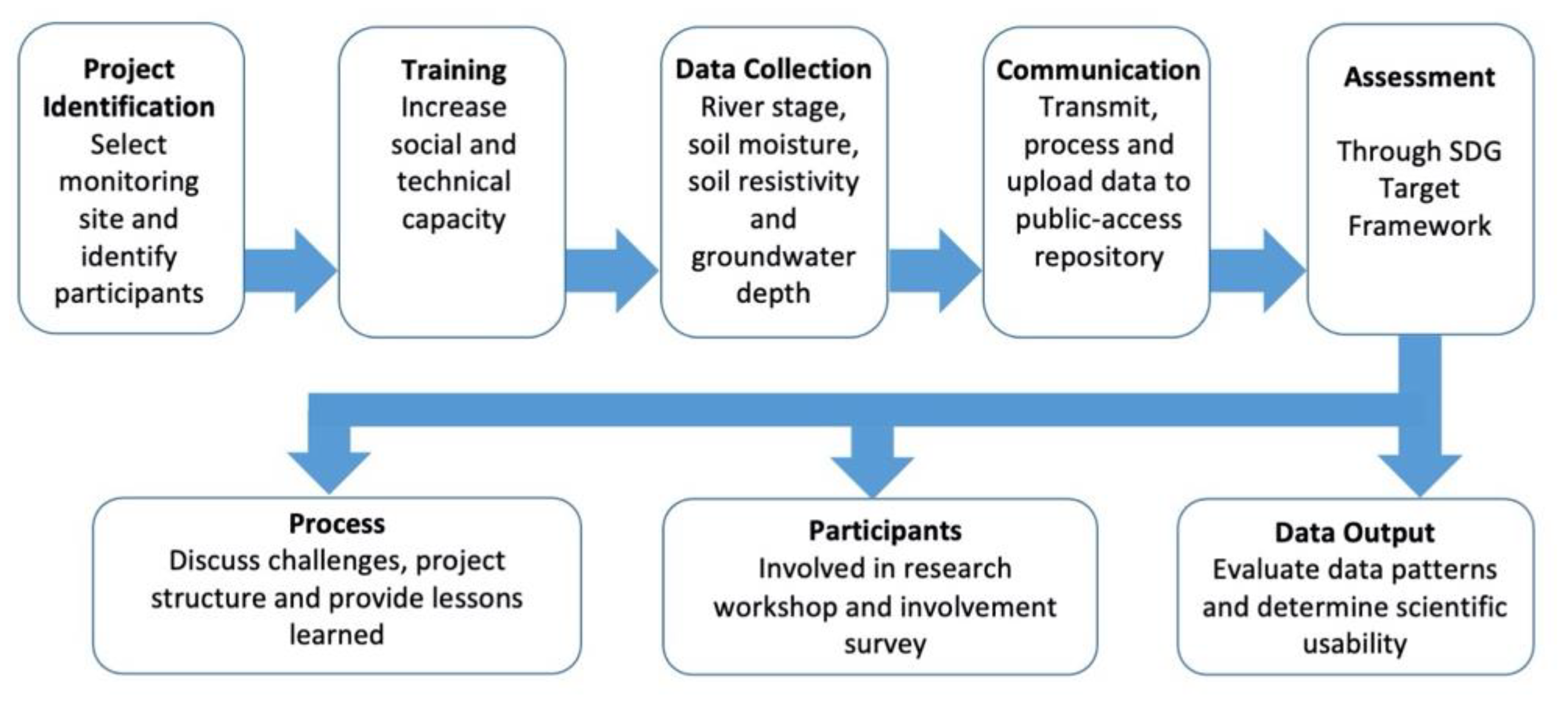
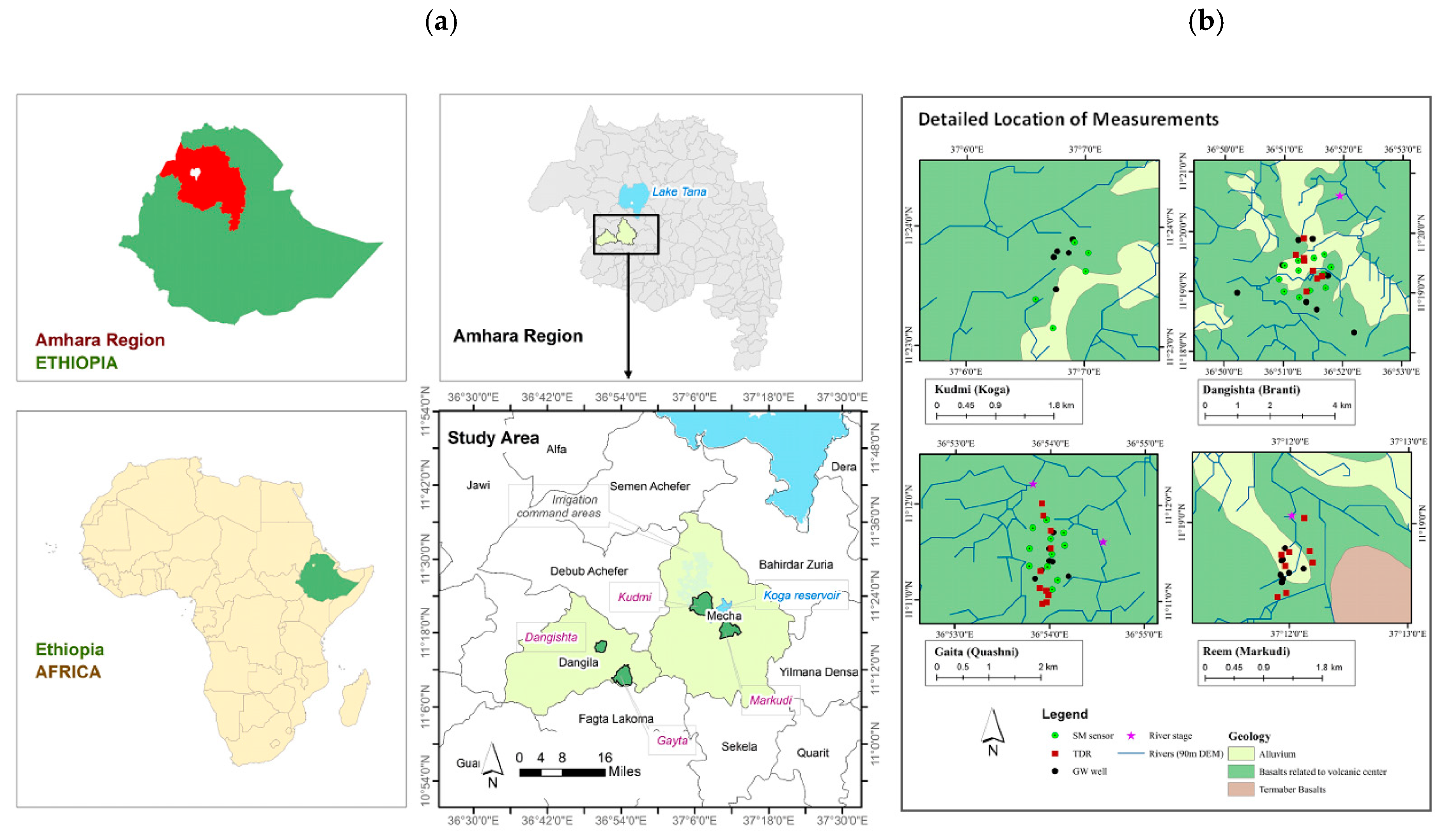
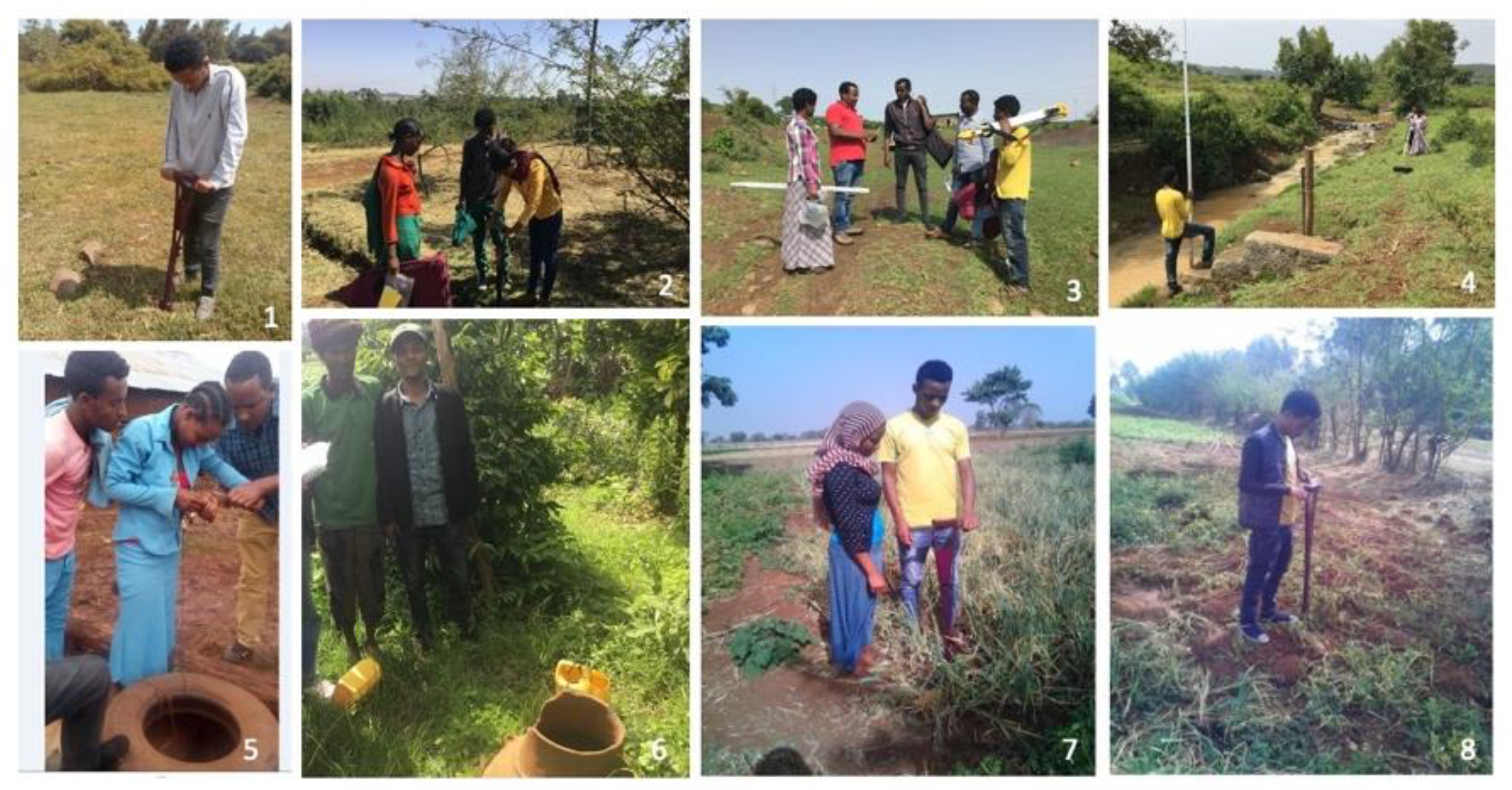
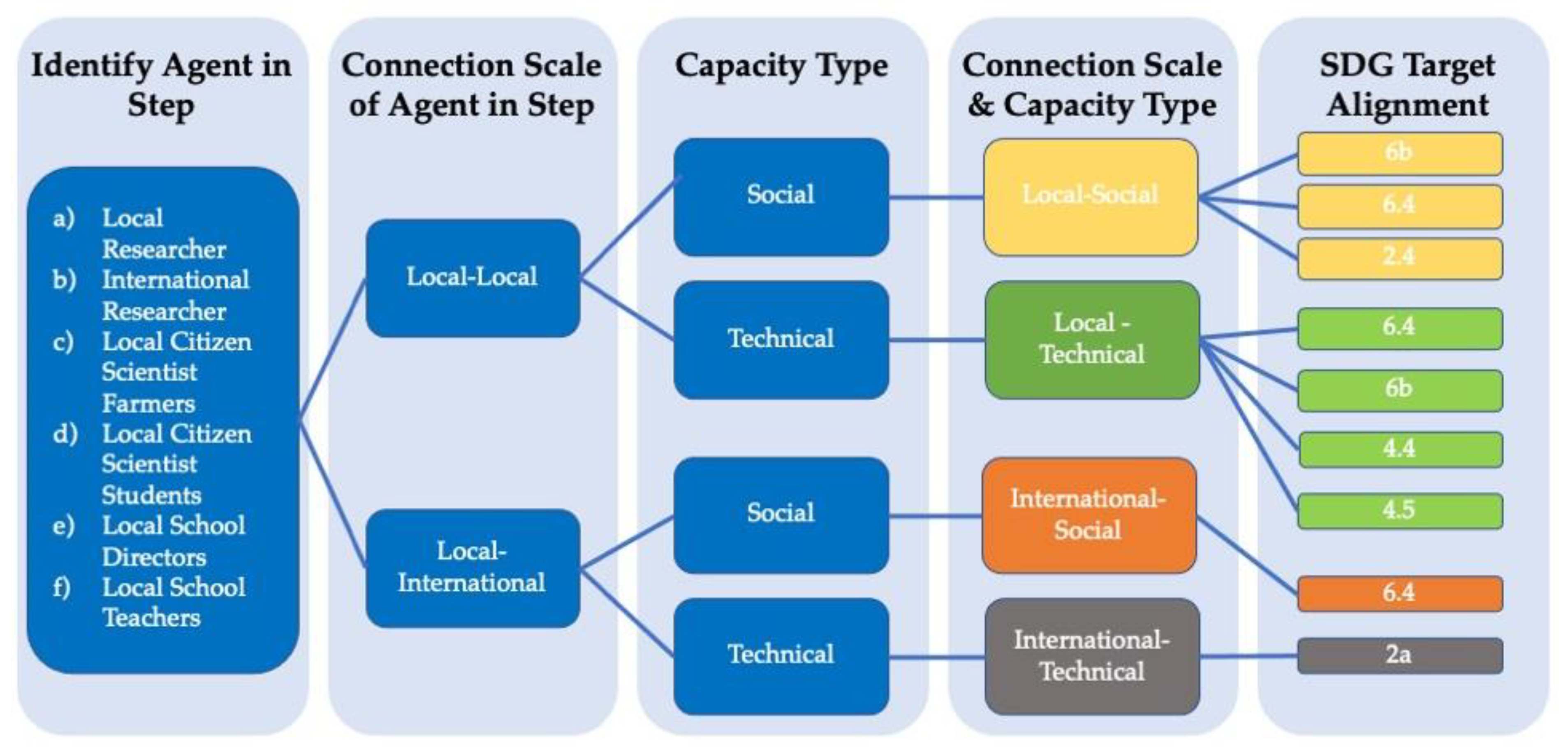

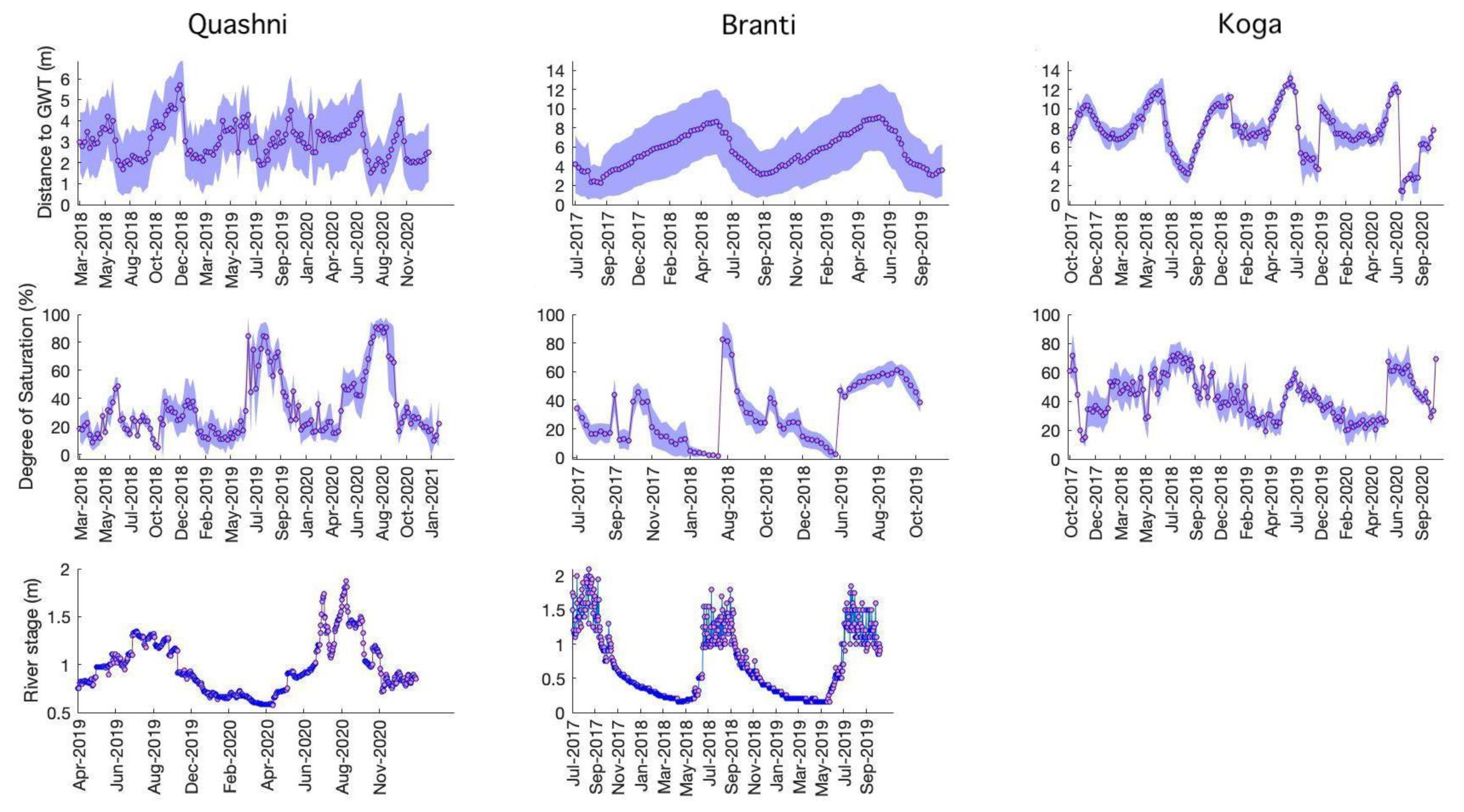
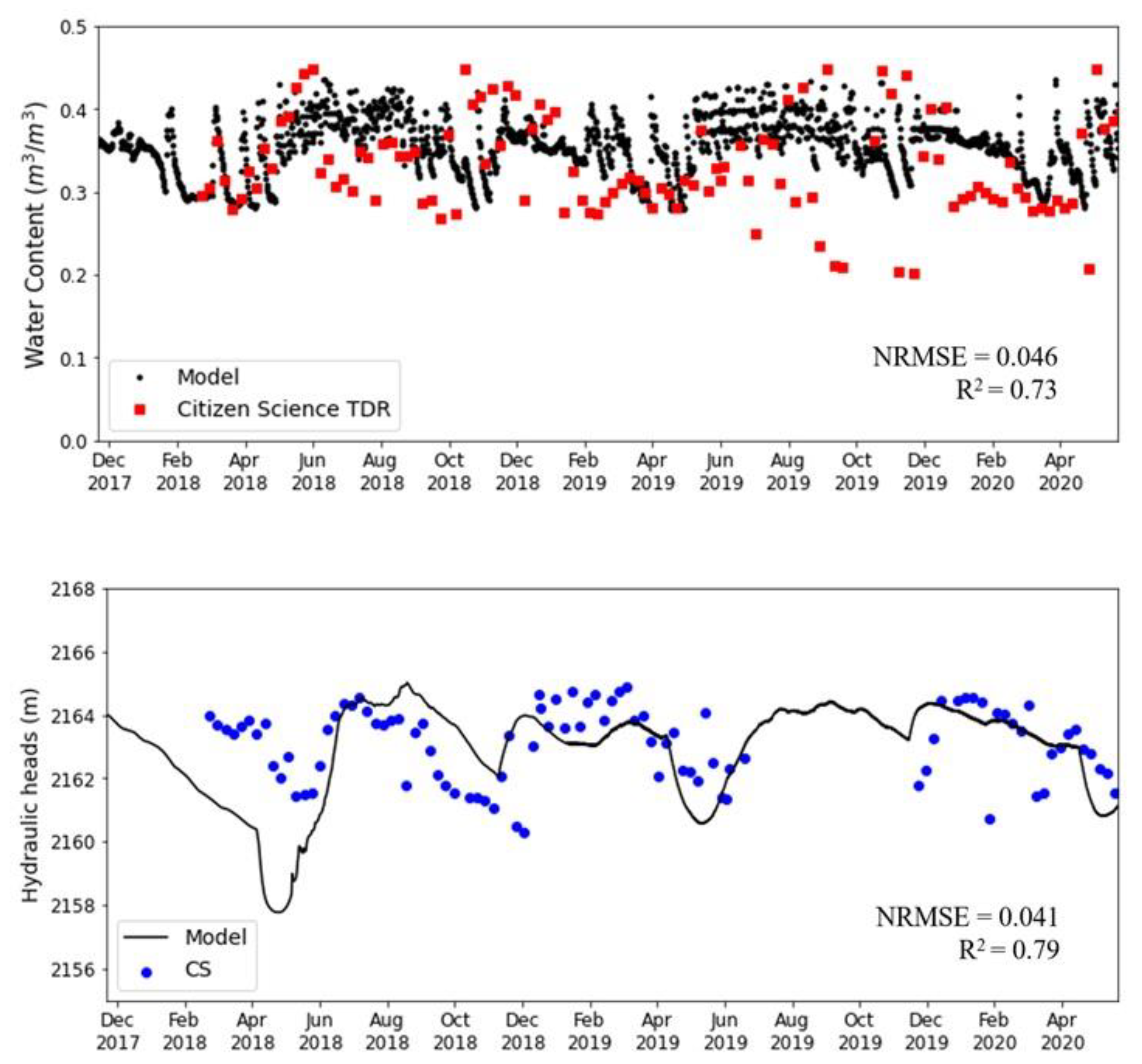
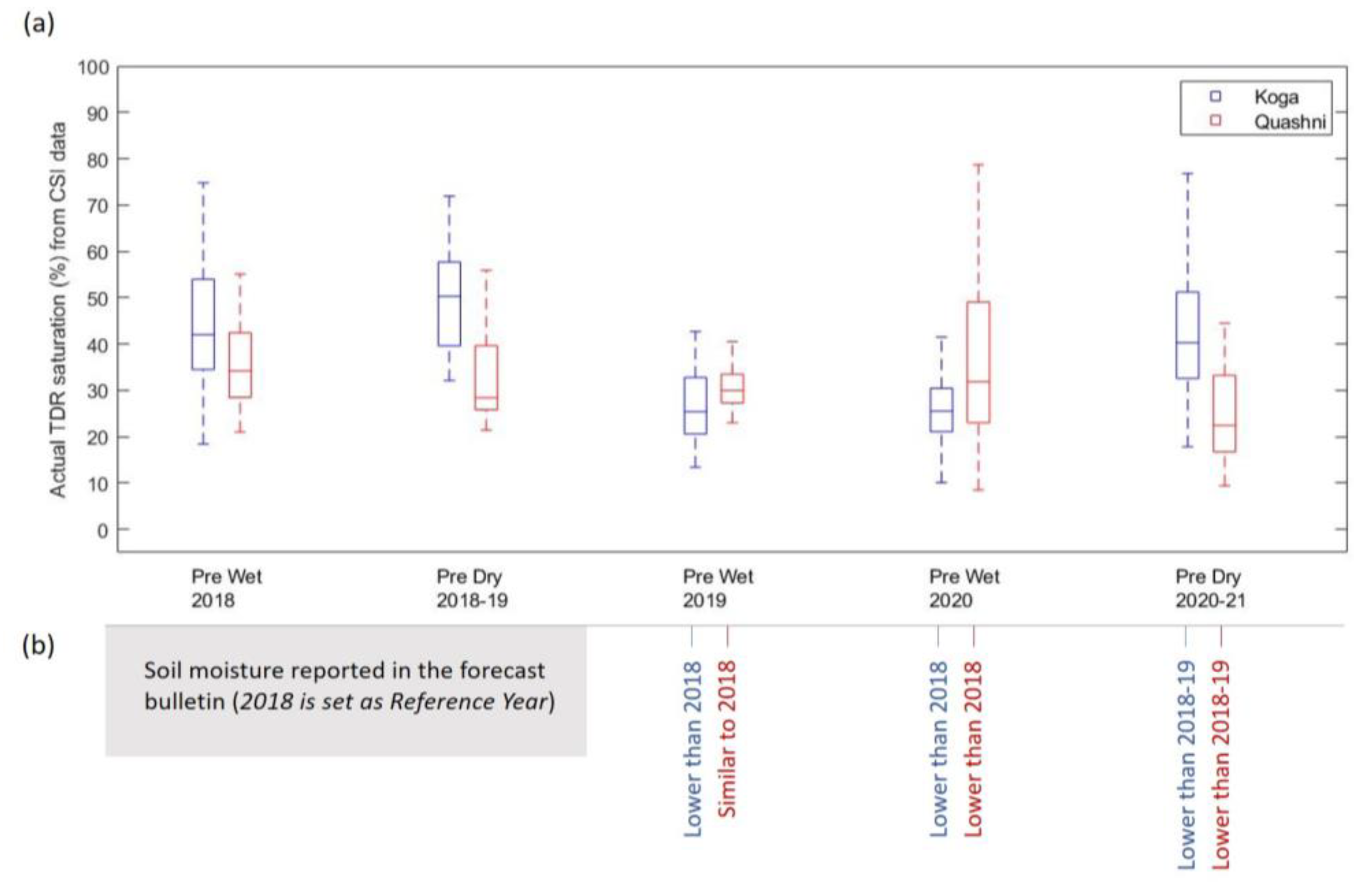
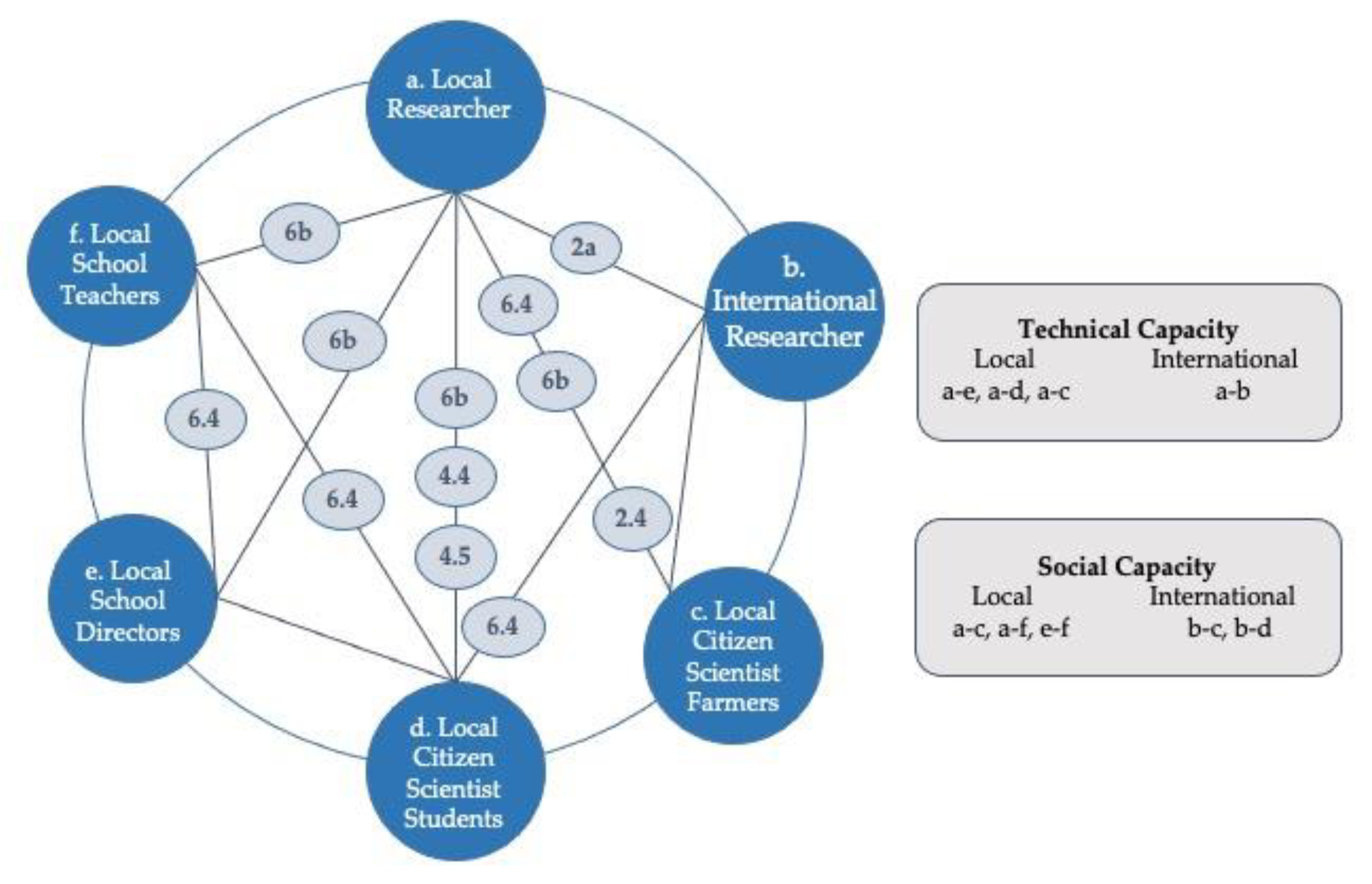

| Students | Farmers |
|---|---|
| Live near the school | Model farmer 1 |
| Be in good academic standing | Ability to write and speak the local language fluently |
| Age 17–24 | Able to interact with graduate students easily |
| Be active in communication | Age 45 or below |
| Gender balance among sites (6 men, 3 women) | Societal acceptance |
| Gender balance was not achieved because women farmers are engaged in household-based tasks |
| Location | Hydrological Parameter | Frequency | Number of Locations | Start Date | End Date | Principal Citizen Science Investigator |
|---|---|---|---|---|---|---|
| Branti Rainfed 1 | River Stage, m | Daily | 1 | July 2017 | December 2021 | Students |
| Soil Moisture, % | Weekly | 8 | July 2017 | December 2021 | Students | |
| Depth to GWT, m | Weekly | 28 | July 2017 | December 2021 | Students | |
| Soil Resistivity 2, Ω | Weekly | 12 | June 2018 | December 2020 | Farmers | |
| Markudi Rainfed 3 | River Stage | Daily | 1 | September 2018 | December 2020 | Students |
| Soil Moisture | Weekly | 8 | September 2018 | December 2020 | Students | |
| Depth to GWT | Weekly | 11 | September 2018 | December 2020 | Students | |
| Soil Resistivity | Weekly | 12 | September 2018 | December 2020 | Farmers | |
| Koga Irrigated 4 | Soil Moisture | Weekly | 9 | October 2017 | December 2021 | Students |
| Depth to GWT | Weekly | 5 | October 2017 | December 2021 | Students | |
| Soil Resistivity | Weekly | 6 | June 2018 | December 2021 | Farmers | |
| Quashni Irrigated 5 | River Stage | Daily | 1 | March 2018 | December 2021 | Students |
| Soil Moisture | Weekly | 9 | March 2018 | December 2021 | Students | |
| Depth to GWT | Weekly | 5 | March 2018 | December 2021 | Students | |
| Soil Resistivity | Weekly | 6 | December 2019 | December 2021 | Farmers |
Publisher’s Note: MDPI stays neutral with regard to jurisdictional claims in published maps and institutional affiliations. |
© 2022 by the authors. Licensee MDPI, Basel, Switzerland. This article is an open access article distributed under the terms and conditions of the Creative Commons Attribution (CC BY) license (https://creativecommons.org/licenses/by/4.0/).
Share and Cite
Rigler, G.; Dokou, Z.; Khadim, F.K.; Sinshaw, B.G.; Eshete, D.G.; Aseres, M.; Amera, W.; Zhou, W.; Wang, X.; Moges, M.; et al. Citizen Science and the Sustainable Development Goals: Building Social and Technical Capacity through Data Collection in the Upper Blue Nile Basin, Ethiopia. Sustainability 2022, 14, 3647. https://doi.org/10.3390/su14063647
Rigler G, Dokou Z, Khadim FK, Sinshaw BG, Eshete DG, Aseres M, Amera W, Zhou W, Wang X, Moges M, et al. Citizen Science and the Sustainable Development Goals: Building Social and Technical Capacity through Data Collection in the Upper Blue Nile Basin, Ethiopia. Sustainability. 2022; 14(6):3647. https://doi.org/10.3390/su14063647
Chicago/Turabian StyleRigler, Genevieve, Zoi Dokou, Fahad Khan Khadim, Berhanu G. Sinshaw, Daniel G. Eshete, Muludel Aseres, Wendale Amera, Wangchi Zhou, Xingyu Wang, Mamaru Moges, and et al. 2022. "Citizen Science and the Sustainable Development Goals: Building Social and Technical Capacity through Data Collection in the Upper Blue Nile Basin, Ethiopia" Sustainability 14, no. 6: 3647. https://doi.org/10.3390/su14063647
APA StyleRigler, G., Dokou, Z., Khadim, F. K., Sinshaw, B. G., Eshete, D. G., Aseres, M., Amera, W., Zhou, W., Wang, X., Moges, M., Azage, M., Li, B., Holzer, E., Tilahun, S., Bagtzoglou, A., & Anagnostou, E. (2022). Citizen Science and the Sustainable Development Goals: Building Social and Technical Capacity through Data Collection in the Upper Blue Nile Basin, Ethiopia. Sustainability, 14(6), 3647. https://doi.org/10.3390/su14063647







